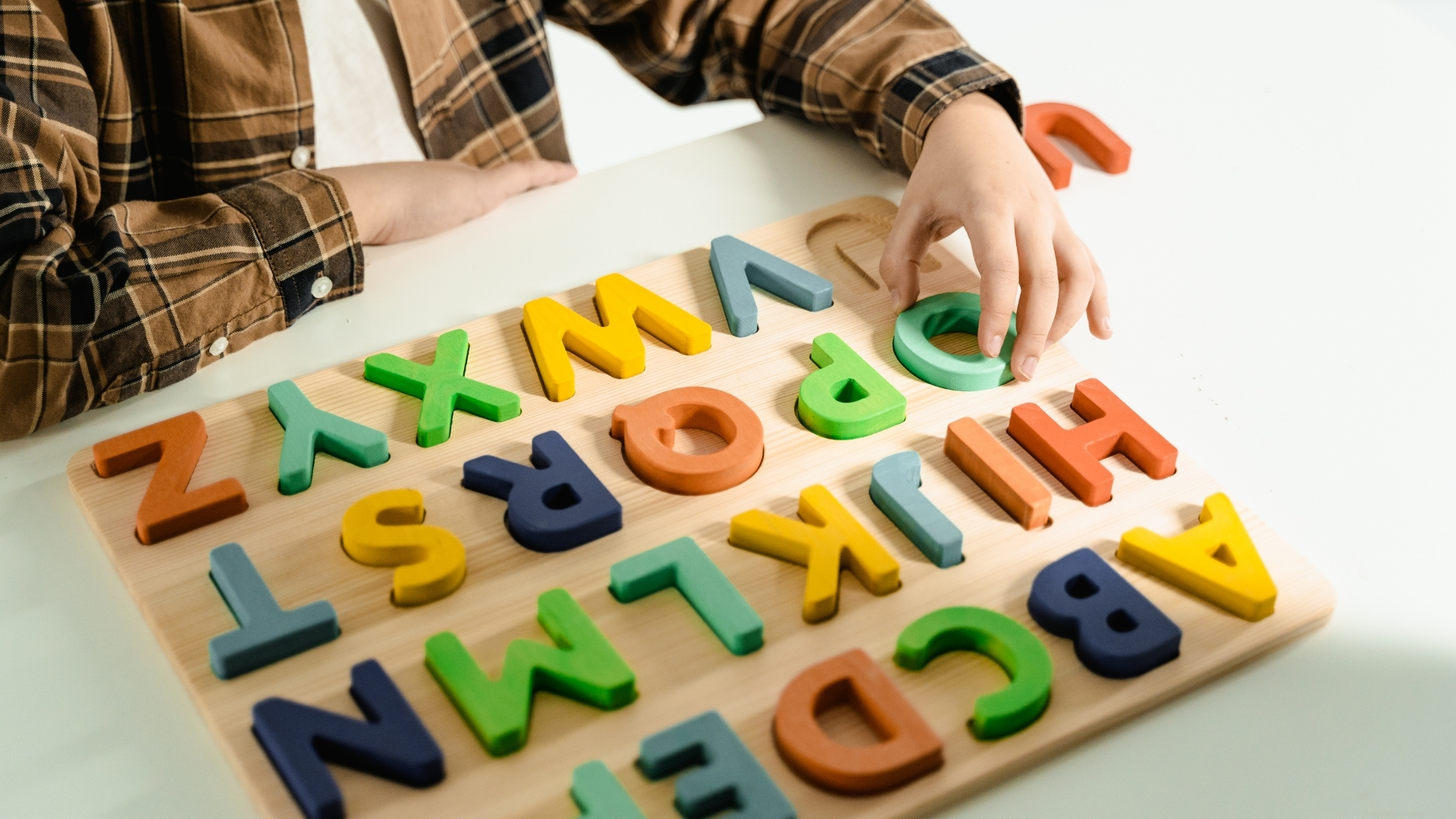When it comes to teaching young children to read, the alphabetic principle is one of the most critical building blocks. It's the foundation that helps children connect letters with sounds, making reading and writing possible. However, many parents and teachers often lack clarity on what this principle truly means and how vital it is for literacy development.
In this blog, we'll break down what the alphabetic principle is and why it's so important. We'll also address the challenges kids face when learning the alphabetic principle and share helpful teaching strategies. Whether you're concerned about your child struggling to read or simply want to give them a head start, this blog will offer you actionable insights and strategies to help guide your child toward reading success.
TL;DR
-
The alphabetic principle links letters to sounds, which is crucial for early reading and writing development.
-
Phonological awareness (recognizing and manipulating sounds) is a key foundation for mastering the alphabetic principle.
-
Common challenges include difficulty with letter-sound connections, inconsistent spelling patterns, and gaps in phonemic awareness.
-
Practical strategies for teaching include explicit letter-sound instruction, interactive games, and consistent practice.
-
Early mastery of the alphabetic principle leads to stronger literacy skills, better word decoding, and increased reading confidence.
What is the Alphabetic Principle?
The alphabetic principle is a simple yet powerful idea: letters and letter combinations represent sounds in spoken words. It's the core idea behind reading and writing - helping children recognize that letters aren't just symbols, but sound-makers that can be combined to form words.
The alphabetic principle enables children to discover how written words correspond to spoken language. For example, when children see the word "cat," they know the letters "c," "a," and "t" each stand for a particular sound: /k/, /a/, and /t/. When they blend these sounds, they can say the word "cat."
But understanding the alphabetic principle isn't just about memorizing letter names or sounds. It's about connecting the dots between spoken language and written language in a meaningful way. This connection helps children decode words, making reading easier, more fluid, and more enjoyable.
Why does the alphabetic principle matter so much?
-
Mastering this principle is foundational for literacy. A child who understands that letters represent sounds is well on their way to becoming a confident reader and writer.
-
And it's not just about reading words on a page. It's about giving children the tools they need to express themselves, improve their communication skills, and build their confidence in school.
For parents and teachers, this principle represents a gateway to success in early education. If children don't develop a clear understanding of how letters and sounds work together, it can lead to a snowball effect of learning challenges.
Now, let's get deep into this principle and explore the building blocks that make it work.
Also Read: 5 Simple Steps To Teach Kids To Read
The Key Components of the Alphabetic Principle

To fully grasp the alphabetic principle, it's important to break it down into its core components. Each of these elements plays a crucial role in helping children read, write, and understand the connection between spoken and written language.
Here's a closer look at the key parts of the principle:
1. Letter-Sound Correspondence
The first step in understanding the alphabetic principle is recognizing that each letter of the alphabet makes a distinct sound. For example, the letter "b" makes the /b/ sound, while the letter "a" makes the /a/ sound, like in the word "bat."
-
Think about how important this is: without letter-sound correspondence, a child would be lost trying to figure out how to read or spell a word. Once they master this connection, they can begin to sound out words, giving them the ability to read unfamiliar words with ease.
2. Phoneme-Grapheme Correspondence
Once children grasp the idea that letters represent sounds, the next step is learning how phonemes (the sounds we hear in words) are represented by graphemes (the letters or letter combinations we see).
-
For example, in the word “phone,” the “ph” makes the /f/ sound. In the word “cat,” the letter “c” represents the /k/ sound. It's all about understanding that letters can combine to make different sounds, and this is key to reading more complex words.
Fun Fact: English has about 44 different sounds (phonemes), but only 26 letters in the alphabet. So, some letters, like "c" and "k," can represent the same sound. This makes learning to read and spell tricky, but also fascinating!
3. Blending Sounds Together
This is where the alphabetic principle really starts to come to life. Once children understand letter-sound correspondence and phoneme-grapheme connections, they can begin to blend sounds to form words.
-
For example, if a child knows the sounds /c/, /a/, and /t/, they can blend these to form the word "cat." This process is one of the most critical skills in early reading, as it allows children to read new words on their own, without having to memorize each one.
Now, why are these components important?
Imagine a child reading a new book with words they've never seen before. Instead of feeling stuck or frustrated, they can sound out the unfamiliar words and feel a sense of accomplishment as they recognize that reading is a skill they can use independently.
These fundamentals make them active readers. They start applying the alphabetic principle to new words they encounter, using their knowledge of letter-sound correspondences and blending to read confidently.
Now that we've covered the core components, it's crucial to understand how phonological awareness supports these concepts.
Also Read: Benefits of Reading Aloud for Children
Phonological Awareness: The Foundation of the Alphabetic Principle
Before children can understand that letters represent sounds, they first need to hear those sounds clearly. This is where phonological awareness plays a critical role. It's the ability to recognize and manipulate sounds in spoken words, a skill that underpins the entire process of learning to read and write.
Phonological awareness includes:
-
Recognizing rhymes (like "cat" and "hat").
-
Identifying beginning sounds (the /b/ in "bat").
-
Segmenting words into individual sounds (breaking "dog" into /d/, /o/, /g/).
Why is this important? Because phonological awareness helps children start to "hear" language in ways that make it possible to connect sounds to letters, it is the core of the alphabetic principle.
For example, if a child can identify the /m/ sound in "man" and recognize it consistently across different words (like "moon" or "mat"), they're developing the skill to match sounds to letters. Once they've mastered this, they can use it to read and spell new words, like "map" or "mat.”
Phonological awareness isn't just a nice-to-have skill - it's crucial for decoding. This skill builds the confidence kids need to tackle more complex reading tasks later on.
With phonological awareness in mind, let's take a closer look at some of the most common challenges students face when learning the alphabetic principle.
Common Challenges in Learning the Alphabetic Principle

Learning the alphabetic principle isn't always straightforward. While it's a critical skill for literacy, many children face challenges that can make it feel like a struggle. Understanding these challenges can help parents and teachers better support students and guide them through the learning process.
Let's take a look at the most common hurdles and how they can be overcome.
1. Difficulty with Letter-Sound Correspondence
The first major challenge is the difficulty some children face in associating letters with the correct sounds. It's one thing to know what the letter "b" looks like, but it's another to understand that it represents the /b/ sound in "bat."
For example, children often confuse letters that look similar but sound different, like "b" and "d." The flip-flopping between these letters can confuse, especially when children start reading and writing words.
2. Inconsistent Spelling Patterns in English
English spelling can be tricky, mainly because the language has so many inconsistent patterns. These irregularities can confuse young learners as they try to apply letter-sound knowledge to unfamiliar words.
Example: The word "cough" is a prime example of how English doesn't always follow predictable patterns. The "ough" in "cough" sounds like /f/, while in "though," it sounds like /oʊ/. Learning to read and spell words with such irregular patterns can feel like a guessing game, especially for children still grasping the alphabetic principle.
3. Phonemic Awareness Gaps
While phonological awareness is crucial, phonemic awareness (the ability to isolate and manipulate individual sounds within words) can be especially tricky for some children. If a child struggles to break down words into their sounds, they might have trouble pronouncing or spelling even simple words.
Example: If a child can't hear that the word "chip" has three sounds—/ch/, /i/, and /p/—they may have difficulty reading or spelling similar words. This is a critical stage of literacy development, and without strong phonemic awareness, reading becomes a challenge.
4. Lack of Consistent Practice and Support
Finally, some children struggle because they don't have consistent practice or enough instructional support. Understanding the alphabetic principle requires repetition and time. Without regular exposure to letter sounds, blending exercises, and phonemic practice, it can take longer for children to catch on.
While these challenges are common, there are proven strategies to overcome them. Next, we'll go through practical methods to teach the alphabetic principle to help students succeed.
Also Read: 5 Strategies to Assist Your Year 5 Child Struggling With Reading and Writing
Productive Strategies for Teaching the Alphabetic Principle
Teaching the alphabetic principle is not a one-size-fits-all approach. Some children pick it up quickly, while others need extra support and practice. The key is to use engaging, targeted strategies that build on each child's unique needs, making the learning process feel both natural and fun.
Here are some tried-and-true methods that can help kids grasp this concept.
1. Explicit Letter-Sound Instruction
The first step is teaching children the connection between letters and their sounds. This needs to be explicit and clear.
For example, when teaching the letter "m,” you don't just show the letter; you make the /m/ sound repeatedly and have the child repeat it. You can even reinforce this by associating the letter with familiar objects (like “m” for “mat,” “m” for “moon”).
2. Interactive Games and Activities
Kids learn best when they're engaged, so turning letter-sound learning into a game is incredibly useful. Here are a few fun ideas:
-
Sound Sorting: Have a collection of objects or pictures (like “cat,” “dog,” and “bat”) and ask your child to sort them by their starting sounds. This reinforces the idea that words share familiar sounds.
-
I Spy with My Little Eye: Play “I Spy” using sounds. For example, “I spy something that starts with the /b/ sound.” This can help kids practice letter-sound recognition in a playful, non-pressure setting.
-
Blending Games: Use simple CVC (consonant-vowel-consonant) words like “dog” or “hat” and have the child mix the sounds to say the word. You can make this interactive by using letter cards and letting them physically blend the letters to form the word.
3. Repetition with a Twist
Repetition is key, but it’s important to keep things fresh. Frequent practice reinforces memory, but if it becomes monotonous, kids can lose interest. Variety is necessary. Mix up activities to reinforce letter-sound connections while keeping them engaged.
-
For example, after several rounds of “sound sorting,” try a different game, like letter matching or reading a short story where they identify the letter-sounds they've learned.
4. Focus on Rhyming and Word Families
Rhyming is a powerful tool for understanding the alphabetic principle. When children learn word families (like “cat,” “hat,” and “bat”), they begin to see how changing one letter can change the whole word. This helps them see patterns and become comfortable with blending sounds to create new words.
One simple activity is to create a "word family chart". Group words that share similar sounds and let the child practice reading them aloud. For example, start with words like “mat,” “pat,” “sat,” and move on to other word families as they get more comfortable.
5. Multi-Sensory Techniques
Sometimes, the best way for a child to understand something is by engaging multiple senses. If a child can both see and hear the sound while associating it with a physical activity, it strengthens the connection. For instance:
-
Letter Writing: Have the child write the letter in the air with their finger while saying the sound out loud. This engages both the visual and motor senses.
-
Sound Exploration with Objects: Use objects or toys that begin with different letter sounds, like a ball for “b,” a cup for “c,” etc. Have the child touch the object and say the sound as they explore it.
This kind of multi-sensory learning can help children who struggle with auditory or visual learning difficulties, as it incorporates a more holistic approach to phonics and literacy.
Conclusion
Learning the alphabetic principle is crucial for your child's literacy development. It forms the foundation for reading and writing, enabling students to decode new words with confidence and ease. Understanding the connection between letters and sounds gives children the tools they need to succeed in school and beyond.
If your child is facing challenges with reading, it's important to address these early and provide the right support. Funfox's interactive online tutoring programs offer a customized approach to help students learn the alphabetic principle in a fun, engaging environment. Our small-group classes focus on building foundational skills in a personalized way, making sure that each child receives the attention they need to thrive.
To give your child the best possible start in their literacy journey, register for a free trial class with Funfox today and discover how our programs can support your child's reading and writing success!
FAQs
1. At what age should my child start learning the alphabetic principle?
Ideally, children should begin learning the alphabetic principle in Kindergarten or Year 1 when they're developing basic literacy skills. Funfox tailors its programs to suit children at all stages, whether they're just starting or need extra support.
2. How does Funfox help kids struggling with phonics?
Funfox uses interactive activities and small-group sessions to focus on phonics. We break down letter-sound connections with hands-on, fun exercises, helping children make clear connections that improve both reading and writing.
3. How is Funfox's teaching different from regular classroom teaching?
Funfox offers personalized attention in small, interactive online groups. While classrooms may struggle to give one-on-one time, our approach adjusts to each child's needs, allowing for focused learning on areas that need attention.
4. How does Funfox support English Language Learners (ELLs)?
Funfox's programs include visual aids, hands-on exercises, and phonological activities to help ELLs connect sounds to letters, build confidence, and improve reading skills at their own pace.
5. How can I monitor my child's progress in Funfox's program?
You'll receive regular updates on your child's development, with feedback on key skills such as letter-sound correspondence and blending. This allows you to stay involved and track growth throughout the tutoring process.















